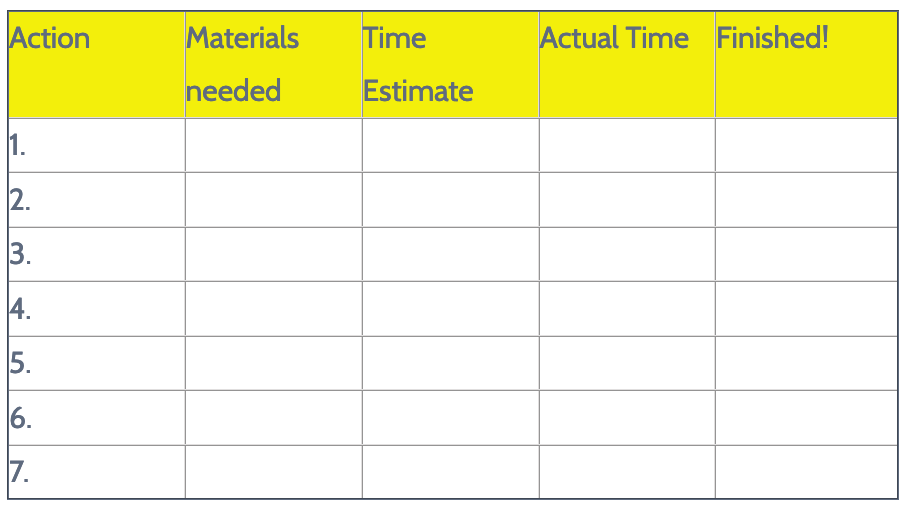Personal Project Planners
 Whether it’s writing a paper or cleaning up your desk, some projects are just hard to get to and even harder to finish. You simply consider organizing the mound of papers and junk on your kitchen table and a wave of fatigue sweeps over you, causing you to run suddenly for the couch in front of the television or your comfortable bed. Or, you mention the dreaded task like writing that college essay and your daughter suddenly has field hockey practice and hastily leaves the house. Starting a task that seems unpleasant or problematic, creating steps to move it along, and then completing it can be challenging for EVERYONE, especially people with ADHD. The project, the chore, and the paper all seem insurmountable because they appear overwhelming. The key to to success is breaking them into manageable parts. When you, your child or student create a customized plan that creates these , then you are already on the road to completion. Although there are many how-to forms for homework, chores and long-term projects, many of them are complicated and labor intensive. The goal of using any form is to provide structure for the planning, prioritizing and sequencing aspects of executive functioning skills that get you from the beginning to the end of a task. Here’s how you can create your own forms that suit you (and your child’s) specific management skills which will take some effort in the beginning but will definitely yield results. You will need a pen and a piece of paper.
Whether it’s writing a paper or cleaning up your desk, some projects are just hard to get to and even harder to finish. You simply consider organizing the mound of papers and junk on your kitchen table and a wave of fatigue sweeps over you, causing you to run suddenly for the couch in front of the television or your comfortable bed. Or, you mention the dreaded task like writing that college essay and your daughter suddenly has field hockey practice and hastily leaves the house. Starting a task that seems unpleasant or problematic, creating steps to move it along, and then completing it can be challenging for EVERYONE, especially people with ADHD. The project, the chore, and the paper all seem insurmountable because they appear overwhelming. The key to to success is breaking them into manageable parts. When you, your child or student create a customized plan that creates these , then you are already on the road to completion. Although there are many how-to forms for homework, chores and long-term projects, many of them are complicated and labor intensive. The goal of using any form is to provide structure for the planning, prioritizing and sequencing aspects of executive functioning skills that get you from the beginning to the end of a task. Here’s how you can create your own forms that suit you (and your child’s) specific management skills which will take some effort in the beginning but will definitely yield results. You will need a pen and a piece of paper.
- Choose the topic or task and write that on the top of the paper.
- Make a grid with 3 vertical columns and several horizontal ones. Label the columns “Possibilities, Pros, Cons.” It should look like this:

- Put any ideas about the project in the possibilities column, followed by what is good and bad about that idea. For example, if the task is organizing the stuff in the basement, the possibilities list might range from “taking everything to the dump” to “getting rid of anything that I haven’t used in 5 years.”
- Create the sequential steps needed to accomplish the task using another grid with 5 vertical columns and several horizontal ones. Use the labels suggested below OR create your own. Make as many numbered rows as required to finish the project. Make the actions as specific as possible. Estimating the time it takes to do a step and then comparing that guess with the actual time the passed improves those all-important time management skills as well!
 Although many kids and adults with ADHD often reject the structure and practice of this process, I have found that my clients ultimately embrace such programs and find them extremely helpful. These “roadmaps” reduce anxiety, clarify goals and build confidence as activities are completed. So, swallow any resistance and try one today!
Although many kids and adults with ADHD often reject the structure and practice of this process, I have found that my clients ultimately embrace such programs and find them extremely helpful. These “roadmaps” reduce anxiety, clarify goals and build confidence as activities are completed. So, swallow any resistance and try one today!
